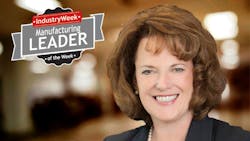Vitamix’s Secret to Success: Workforce has Zest for Life
Sometimes corporations have to face a fork in the road. In 2004, Jodi Berg, CEO of Vitamix, had a decision to make. At the time she was overseeing the household division of the company, which manufacturers high-performance blenders, and her instincts were telling her that now was the time to choose which path the 82-year old family company needed to take.
The company founder, William Grover Barnard, introduced the blender in 1937 after discovering a connection between his illness and the health benefit of whole-food nutrition. The company had experienced great success, but there was still room to grow and in 2004 Berg saw her shot to boost the company to a higher level. Consumers had shifted their attitudes toward food and nutrition and began to see that food could in fact improve health. The market responded and retail stores, such as Jamba Juice, opened up.
“The world was finally ready for high-performance blending of whole foods,” explained Berg. “I had been asking people for years about how they ate and I would hear answers about eating whole foods as a reaction to the treatment of animals. But now I was hearing people say they felt better when they ate this way. It was a huge shift.”
To prepare her company, which would have to transform every aspect of operations -- manufacturing, purchasing, distribution -- to meet this new demand, she wanted to see how the workforce would react.
She turned to a local university in Cleveland, Case Western Reserve University, and asked them to survey her employees to find out what they liked about working at Vitamix. She discovered that both the family feeling of the company and its strong sense of integrity ranked high. So she took these values, added customer, quality and team work and those became the five core values of the company. She promised her employees that she wouldn't change those values even as she changed the entire organization.
Her instincts were right and the company found additional markets, such as the restaurant and hospitality industries.The company has experienced year after year of double digit growth.
In fact since 2013 the company has seen 45% year-over-year growth.The brand is a top seller at high-end stores such as Williams-Sonoma, and its corporate clients include Starbucks and McDonald’s.
The high growth is a direct result of the continued emphasis on the company's culture. “We are able to have high production at our plant because we help employee release the power they have to figure out how to work within our core values to satisfy all stakeholders, while creating financial success,” says Berg.
Vitamix's lean process will be on display as the company is conducting a plant tour during the IndustryWeek Manufacturing & Technology Conference & Expo in Cleveland, Ohio on May 8-10.
Berg is strongly committed to her motto; " Our purpose is to liberate and nourish our zest for life."
And she is very careful about who she brings into the organization. “We look for employees who have energy and enjoy their lives," Berg explains. "We want our company to be a vehicle to release, unshackle, nurture and support people’s experiences to heighten the flavor of all aspects of their lives.”
Berg demands this same level of awareness of herself.To figure out whether something fits into her values, she uses the acronym DANCE to guide her action.
D: Determine your destiny. Who do you want to be? We spend more time planning our family vacations than figuring out our futures.
A: Make sure your world is aligned around that destination.
N: Make sure you have a network, because you can't do it alone. Surround yourself with people who will help you get there.
C: Care for yourself first. You have to be healthy for the people who rely on you.
E: Enjoy the process. Celebrate a little bit
